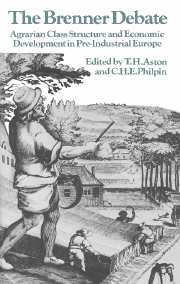Book contents
- Frontmatter
- Contents
- Preface
- Introduction
- 1 Agrarian Class Structure and Economic Development in Pre-Industrial Europe
- 2 Population and Class Relations in Feudal Society
- 3 Agrarian Class Structure and the Development of Capitalism: France and England Compared
- 4 Peasant Organization and Class Conflict in Eastern and Western Germany
- 5 A Reply to Robert Brenner
- 6 Against the Neo-Malthusian Orthodoxy
- 7 A Crisis of Feudalism
- 8 In Search of Agrarian Capitalism
- 9 Agrarian Class Structure and Economic Development in Pre-Industrial Bohemia
- 10 The Agrarian Roots of European Capitalism
- Index
- Past and Present Publications
9 - Agrarian Class Structure and Economic Development in Pre-Industrial Bohemia
Published online by Cambridge University Press: 27 October 2009
- Frontmatter
- Contents
- Preface
- Introduction
- 1 Agrarian Class Structure and Economic Development in Pre-Industrial Europe
- 2 Population and Class Relations in Feudal Society
- 3 Agrarian Class Structure and the Development of Capitalism: France and England Compared
- 4 Peasant Organization and Class Conflict in Eastern and Western Germany
- 5 A Reply to Robert Brenner
- 6 Against the Neo-Malthusian Orthodoxy
- 7 A Crisis of Feudalism
- 8 In Search of Agrarian Capitalism
- 9 Agrarian Class Structure and Economic Development in Pre-Industrial Bohemia
- 10 The Agrarian Roots of European Capitalism
- Index
- Past and Present Publications
Summary
With one exception, all the other contributors to this Symposium on Robert Brenner's article have concentrated on developments in England and France. If they have mentioned the situation in central and eastern Europe at all, it has been merely to make general assertions. The single exception is Heide Wunder, who drew the conclusion that “central European historians have not been particularly successful in presenting their findings to their British and French colleagues”.
In the context of the Brenner debate, the development of Bohemia is of particular significance: first, because of its central geographical location and its consequent economic importance to pre-industrial Europe as a whole; second, because it provides the example of a variant case of development, in marked contrast with the economic and social evolution of England and France. From the mid-seventeenth century onwards Bohemia developed along very different lines from the countries of western Europe. It is thus a useful corrective to any stereotype of the transition from feudalism to capitalism, and offers fresh perspectives on the various issues and problems involved.
In their contribution to this Symposium, M. M. Postan and John Hatcher cite the observation of Z. P. Pach that in Hungary until the end of the fifteenth century “labour dues played a merely subsidiary role” and that the “rural economy was fundamentally concordant with that of the west European countries”. They further expressed the view that “Similar conclusions have emerged from Bohemian and Polish sources, and are contained in the works of Kula, Graus, Malowist and others”.
- Type
- Chapter
- Information
- The Brenner DebateAgrarian Class Structure and Economic Development in Pre-industrial Europe, pp. 192 - 212Publisher: Cambridge University PressPrint publication year: 1985
- 4
- Cited by



